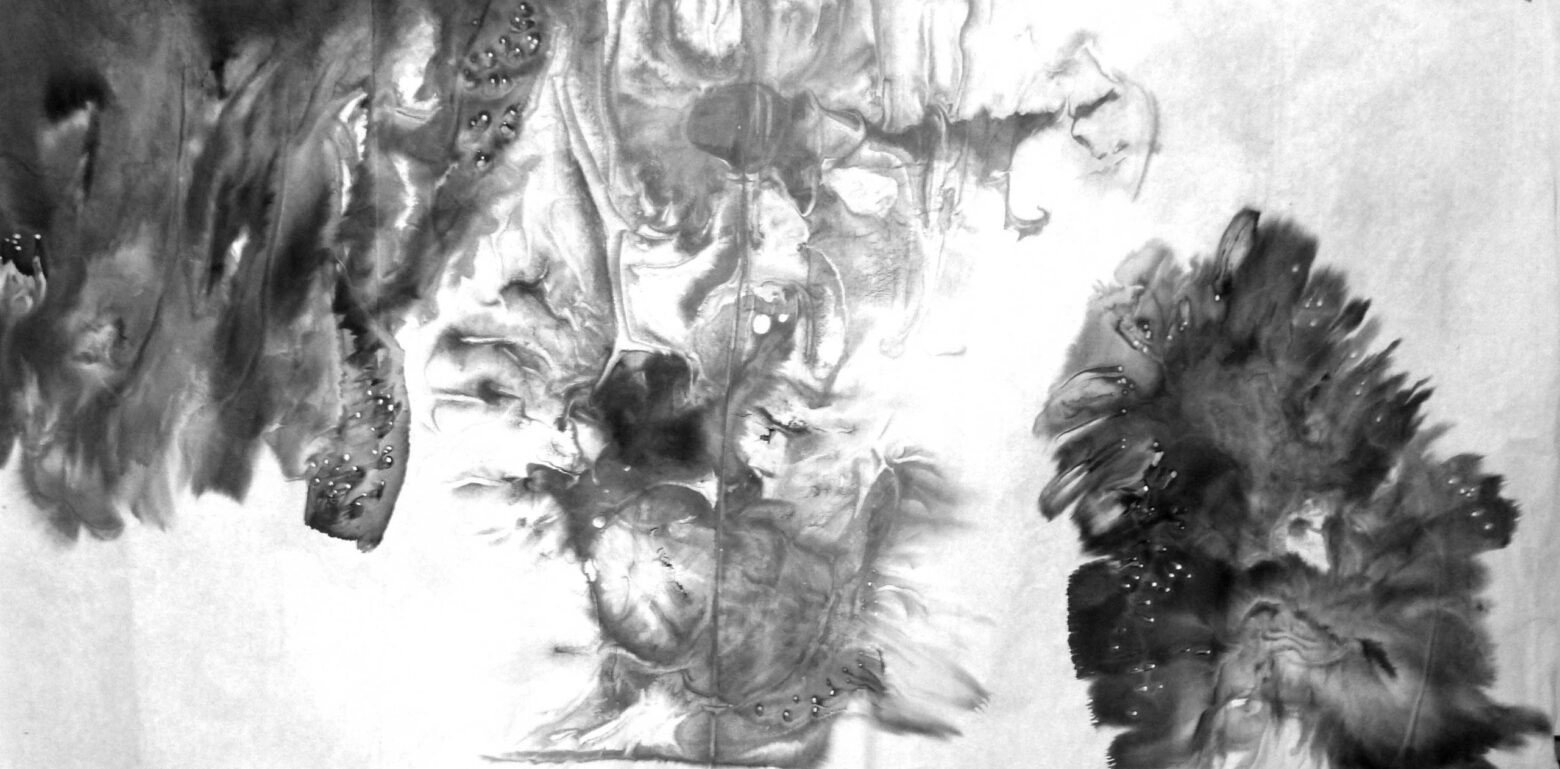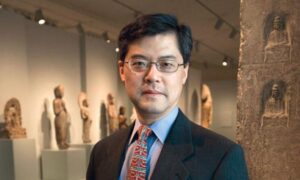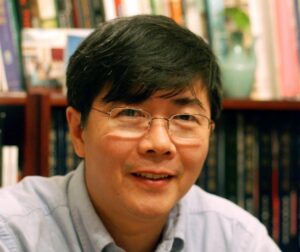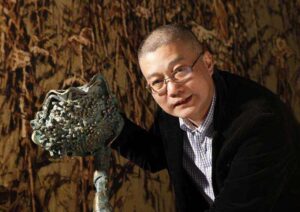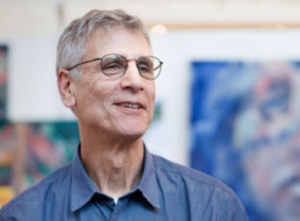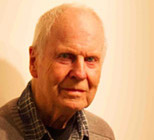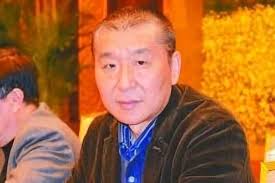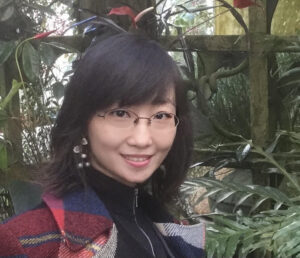Former Deputy Director and Chief Curator of the National Gallery of Art
2007
Poetry in Painting: The Work of Ming Ren
Su Tung-p’o, the great eleventh century scholar, painter and connoisseur wrote of his friend’s work,
When I savour Mo-chieh’s poem’s, I find paintings in them; When I look at Mo-chieh’s paintings, there are poems in them. (1)
In the work of the twenty-first century landscape painter, Ming Ren, one finds poetry as well. Similar to the expressive work of Mo-chieh and of his compatriot, Su Tung-p’o , Ming Ren’s painting goes beyond the uttered word or brushstroke to portray the poetic qualities of nature in an extraordinarily broad manner. Michael Sullivan has written that Su Tung-p’o and his colleagues were revolutionaries whose idea was “that the purpose of painting…was not to depict things…but to express the painter’s own feelings.”(2) Ming Ren similarly creates fields of imagination in which his pigments migrate, separate and merge to create compositions whose randomness establishes organic parallels to observed nature.
Chancellor, School of the Art Institute of Chicago
2009
MING REN:“Magic Happening”
In every artist there’s a solid streak of sheer bravery. My friend the painter Ming Ren has it. Going into the studio to make work on an heroic scale, struggling to overcome the reluctance of paint and materials to do his bidding, fighting to create the right balance between the ideas in the work and the ways of making that bring them to life. And as with most painters, doing this alone. Nothing between him and the work, which stands or falls by his hand alone, in an intense personal and intimate dialogue with ideas and materials. And working on a such large scale requires an unusual amount of planning, to deal with the sheer physicality of production. All challenges and risks are magnified. I have great admiration for artists who take on these challenges.
Director, San Francisco Asian Art Museum
2009
Reading Ming Ren: Some Random Thoughts
I came to know Ming Ren and his work only a little over a year ago when I moved to San Francisco. But once we met, I feel I had known him all along, in a fundamental way. That is because his art demonstrates a life-long, and still ongoing, exploration and negotiation of artistic languages of China and the West, a topic that interests me deeply. Even though Ming Ren’s artistic development may be classified, in an art historical sense, into phases of transformation, or “reincarnations,” there is always the common thread: a determined pursuit to integrate the artistic legacy of his birth country and that of his adopted home, and to create a form of art that is uniquely his. Shuttling back and forth between US and China as both an artist and an art educator, Ming Ren is exerting a tangible influence on the artistic dialogue and trajectory in both places.
Professor, Art History, Theory & Criticism, Vice Chair & Director of PhD Program, UC, San Diego
2017
No Room for Form – Abstract Painting by Four American Artist
Ming Ren’s skilled mastery of the techniques of many different painting mediums enables him to fluently and seemingly effortlessly unlock their potential in his abstract expressionist painting. Although his work is created using a variety of different materials, one can still sense the underlying influence of traditional Chinese ink painting. The collision of color and ink produce a powerful visual shock, but at the same time the painting surface brings forth the profound stillness of the vast cosmos. In this universal calm Ren reveals his understanding of the relationships between humankind and nature found in ancient Chinese philosophy and aesthetics. The works in the present exhibition display his experiments in abstract ink painting of recent years. The most striking of them is a huge work, twelve meters in length, entitled Interactive Ink. This is his collaborative development with Silicon Valley software engineer Dr. Zhang Hansong of an interactive virtual painting. This innovative expressive form combines painting and newly developed motion sensitive software to let the audience directly participate in the re-creation of the work. When the audience passes the long handscroll projected on the screen, the flow and expansion of ink will respond to the speed, quantity, and direction of the viewers’ movements. This experiment opens new potential for the development of Chinese ink art.
President, Minneapolis College of Art and Design
2009
How Qi Finds a Home in the Artist’s Studio
“Fire and water have qi but do not have life. Grasses and trees have life but do not have perceptivity. Fowl and beasts have perceptivity but do not have yi (sense of right and wrong, duty, justice). Men have qi, life, perceptivity, and yi.”
Confucian philosopher, Xun Zi (313BC-238BC)
Each artist decides for himself or herself what particular form of making will best give shape to the meaning they wish to convey. An artist discovers the materials they have an affinity for and marries the processing of those materials with their conceptual message. Through their work their chosen combination of making and reflecting becomes their distinctive contribution to the world. But is it that simple? What conspires to shape those choices? What is the relationship between conscious decision and other forces that interact to give form to the work?
In the case of the work of Ren Ming these questions are particularly relevant. He is a master of his chosen craft, working with pigment and ink on paper. However, the means by which he has chosen to work also gives these materials a great voice in the ultimate form of the work.
President, China Academy of Art
2009
The Wind is Swirling and the Clouds are Floating – Thoughts on Ming Ren’s New Works
When my fellow schoolmate Ming Ren returned from America, he brought back his new catalog of his most recent works. When friends visit from afar, there is always the sense of nostalgia borne by a familiar passing breeze. These new works allow one to experience that, as if one is floating among the clouds.
The word “you” or “float” has numerous connotations in Chinese tradition. It not only can signify the tassels on a flag but also the swaying movement of the tassels in the breeze. Each and every strand of the tassel is borne in the same direction by the wind, yet no two strands move quite the same way. “You” can also connote flowing water , and refreshing experiences similar to that of flowing water. And so, by visiting mountains and streams, one experiences life. And what is seen and felt are consigned to “you”. The ancient Chinese thinker, Zhuang Zi emphasized this concept in his xiao-yao-you. Roughly translated as the “unfettered experience,” the primary idea of the work is the molding of rigid human understanding and reason into something that freely transgresses the boundaries of the world. The “you” among the clouds, or the experience of floating among the clouds, precisely embodies this carefree connotation.
President, California College of Art
2009
A Force of Nature
On a recent Monday evening, I helped my sixteen-year-old son prepare for his upcoming physics test. We reviewed formulas for velocity, gravitational pull, momentum, acceleration, and centripetal force. Immediately following our study session, we began talking about a show of Ming Ren’s paintings that we had both seen. This apparent leap of subject matter was not accidental. With further reflection, and as our conversation developed, we realized that Ming’s paintings were a creative extension of the laws of physics—a leap into a world of unlimited invention merging science and art. His works call to mind the laws of the physical universe while appearing to defy them. They contradict our inculcated perceptions of a unified world governed by gravity and they pull us into new, unfamiliar spaces that challenge Western notions of picture plane and perspective. His paintings manipulate time and space; they fuse the East with the West and reveal new, unexplored territory.
Vice President and Dean of Academic Affairs Emeritus, San Francisco Art Institute
2009
Call and Response, The Paintings of Ming Ren
The work of art calls; the viewer, the listener, the reader responds. The viewer’s senses respond to the seduction of color and light, scale and form, the place of the work in a gallery, a museum, or home (or even the dump—perhaps a shining treasure in the trash). The listener’s body responds to rhythm and melody, to vast chords and complex orchestrations. The reader’s mind responds to the sound of words that bring a lifetime of memory and anticipation. Yes, memory, that is the mind’s response to the work of art’s seduction of the senses. We see, hear and read now, but all of that is in the context of a lifetime of memory. So Ming Ren’s work calls, and the response is as different for every receiver as are the unique memories of every person.
President, Luxun Academy of Fine Arts
2009
Kaleidoscopic Images – In Honor of Ming Ren and His Works
20th century commenced the era of abstractism as a demonstrator of art forms. It integrates reality with spirituality, art with life, internal world with physical ambience, therefore depicts the new cognition of the nature in an astonishing manner.
As an artist, who studied and worked domestically and settled down later in America, Ming Ren is gifted with talents in painting. His works display an all-new horizon: interwoven vigor and power with crystality, thus imposing a feeling of gravity brought about by the transformation of times; or the internal conflicts in such transformation. The works extract and reveal the vivid nature of life hidden behind the superficial appearance.
Curator, Shandong Art Museum, China
2021
Dance With Ink
“While boating on the emerald waves, I feel as if I were wandering inside of the painting.”
Wang Wei (701-761), a revered Tang Dynasty (618-907) Chinese poet and painter in the eighth century, wrote this verse in his poem entitled “Zhou Zhuang River.” The essence and spirit of this artistic realm are most aptly demonstrated in a series of interactive works called “Dance With Ink,” created by Ming Ren, an artist in San Francisco, and completed with the cooperation of Dr. Hansong Zhang, a computer scientist in Silicon Valley. Presently on display at the Ackland Art Museum in the United States, this work is a new model of contemporary art that transforms abstract ink painting into virtual ink art and interacts with the audience in real time by using technology of fluid dynamic interaction. The debut of “Dance with Ink” in Western museums provides us with an opportunity to explore the aesthetic way and artistic value of Chinese black and white ink painting, and also creates a new path for the contemporary and global development of ink art.
